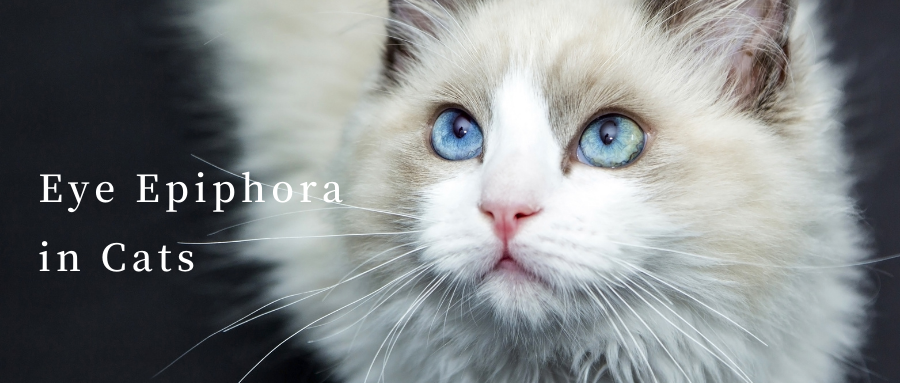Eye Discharge (Epiphora) in Cats
What is epiphora?
Epiphora means an overflow of tears from the eyes. It is a symptom rather than a specific disease and is associated with a variety of conditions. Normally, a thin film of tears is produced to lubricate the eyes and the excess fluid drains into the nasolacrimal ducts, or tear ducts, which are located in the corner of the eye next to the nose. The nasolacrimal ducts drain tears into the back of the nose and the throat. Epiphora is most commonly associated with insufficient drainage of the tear film from the eye. The most common cause of insufficient tear drainage is a blockage of the nasolacrimal ducts or poor eyelid function due to a deformity. Epiphora may also result from the excessive production of tears.
What are the signs of epiphora?
The most common clinical signs associated with epiphora are dampness or wetness beneath the eyes, reddish-brown staining of the fur beneath the eyes, odor, skin irritation, and skin infection. Many owners report that their cat’s face is constantly damp, and they may even see tears rolling off their pet’s face.
How is epiphora diagnosed?
The first step is to determine if there is an underlying cause for the excess tear production. Some of the causes of increased tear production in cats include conjunctivitis (viral or bacterial), allergies, eye injuries, abnormal eyelashes (distichia or ectopic cilia), corneal ulcers, eye infections, anatomical abnormalities such as rolled in eyelids (entropion) or rolled out eyelids (ectropion), and glaucoma.
“The first step is to determine if there is an underlying cause for the excess tear production.”
Once the more serious causes for epiphora have been eliminated, it is necessary to determine if proper and adequate tear drainage is occurring. A thorough ocular examination is performed, paying special attention to the nasolacrimal ducts and nearby tissues, and looking for signs of inflammation or other abnormalities. The facial anatomy of the cat may play a role in this condition. Some breeds (e.g., Persians and Himalayans) have flat or squished-in faces (brachycephalics) that do not allow the tear film to drain properly. In these pets, the tear film fails to enter the duct and simply rolls off the face. In other cases, the hair around the eyes physically obstructs the entrance to the nasolacrimal ducts, or debris or a foreign body forms a plug within the duct and prevents drainage of tears.
One of the simplest tests to assess tear drainage is to place a drop of fluorescein stain in the eye, hold the cat’s head slightly downward, and watch for drainage into the nose. If the drainage system is functioning normally, the eye stain should be seen in the nose within a few minutes. Failure to observe the stain does not definitively diagnose a blocked nasolacrimal duct but it does indicate the need for further investigation.
How is epiphora treated?
If the nasolacrimal duct is suspected of being blocked, your cat will be anesthetized and a special instrument will be inserted into the duct to flush out the contents. In some cases, the lacrimal puncta or opening may have failed to open during your cat’s development, and if this is the case, it can be surgically opened during this procedure. If chronic infections or allergies have caused the ducts to become narrowed, flushing may help widen them.
If the cause is related to another eye condition, treatment will be directed at the primary cause which may include surgery.
What can I do for the staining?
There are many remedies that have been recommended for removing or eliminating the facial staining associated with excess tears. None of these has proven to be 100% effective. Some over-the-counter treatments may be harmful or injurious to the eyes.
Low doses of some antibiotics are no longer recommended due to the risk of developing bacterial antibiotic resistance rendering these valuable antibiotics worthless for human and veterinary use. Some over-the-counter products have been suggested but have not been proven to be effective in research trials.
Do not use any product without consulting with your veterinarian. Avoid using any product containing hydrogen peroxide near the eyes, since these products can cause severe damage if inadvertently splashed into the eyes.
What is the prognosis for epiphora?
Unless an underlying cause can be found and treated, most patients with epiphora will experience intermittent episodes throughout their life. If your cat’s facial anatomy prevents adequate drainage of the tear film, it is likely that some degree of epiphora will persist despite all treatment efforts. In many cases, no significant problems may arise, and the tear staining may be cosmetic. Your veterinarian will discuss the particulars of your cat’s condition and will determine the specific treatment options and prognosis for your cat.
Post time: Nov-24-2022
